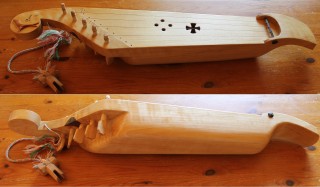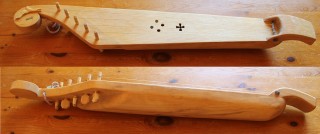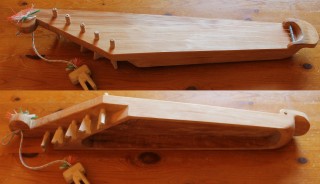Experimenting brass and bronze strings on kanteles made by Billy Horne
Blog
April 25, 2014
Some time ago I visited Billy Horne‘s shop in Turku. Lots of interesting finished and unfinished instruments (like hurdy-gurdys, bowed harps and kanteles) were lying around and hanging above my head; it was like a forest growing musical instruments! The time flew by, and when I finally left, I was carrying a bag full of 5-string kanteles – and a permission to experiment different brass and bronze string solutions on them. Wow, what a journey! And here comes the first results of my experiments. I tuned all kanteles in the same way to be able compare the timbre changes between them, the string #1 in low (appr. -35 cent) A3 flat.
Item #1. A replica of a 5-string kantele originating from Suojärvi, Karelia (Pohjois-Karjalan museo, PKM/LK/521), based on the structural drawing by Rauno Nieminen (published in: Viisikielisen kanteleen rakennuspiirrustuksia, KIJ 14, 1984). The sound box is made of birch, the top plate of spruce. In this instrument I put Malcolm Rose‘s brass wire, diametre 0,40 mm. (By clicking the top of the images you can see them larger.)
The approximate (the measurements were made quickly with a so-so measuring tape) vibrating lengths of the strings:
- 43,8 mm
- 41,1 mm
- 38,4 mm
- 36,0 mm
- 33,6 mm
Item #2. A modified model by Billy; the sound box is made of birch and the top plate of spruce, the tuning pegs of maple. I put Lars Jacobsen‘s brass wire in it, diametre appr. 0,45 mm (0.018 inch). The vibrating length of the strings are longer than in the first kantele, and thus it seemed that with this tuning and wire choise the braking point of the highest string was close. The highest string broke once, but on the second try I was able to get it tuned.
The approximate vibrating lengths of the strings:
- 52,0 mm
- 49,2 mm
- 46,4 mm
- 43,4 mm
- 40,6 mm
Item #3. This one is almost the same as item #2 (the same wood materials also), and that’s why I decided to try the same diametre but bronze wire (0.018 inch, Lars Jacobsen) in it, to be able to perhaps say something about the timbre difference between brass and bronze. The “ponsi” part is carved differently and there are slight diferences also in the size of the sound box and the vibrating lengths of the strings, so naturally no scientifically strong conclusions can be made – just the gut feeling. I didn’t brake any strings with this one, but I had big problems in getting the string #5 tuned; it seemed to stretch and get out of tune endlessly.
The approximate vibrating lengths of the strings:
- 52,9 mm
- 50,0 mm
- 47,1 mm
- 44,2 mm
- 41,6 mm
Item #4. This one is made of alder and it’s hollowed out from below (no back plate). I decided to try thinner bronze wire in it, appr. 0,40 mm (0.016 inch, from Lars Jacobsen). From the very beginning it was easy to tune, and it also stayed in tune well.
The approximate vibrating lengths of the strings:
- 48,0 mm
- 45,1 mm
- 41,8 mm
- 38,8 mm
- 35,7 mm
This experiment partly strengthened my earlier feelings about brass and bronze wire. The Ontrei Malinen replica which I have been playing for about 6 years now, has bronze strings (the wire material in that kantele is a little different than pure bronze), and I love the deep sound it produces. Couple of times it has happened that when I’ve used brass wire on different models, the sound hasn’t been as full and warm as hoped. But then again, it is also true that even small differences in the sound box, wood material or in the structure of the body will have an effect on the sound, as well, and in some cases the brass strings have worked very well giving a rich and mellow timbre.
But this time the bronze won 2-1. Both bronze string kanteles gratified my ears and soul to a great extent and the brass versions seemed to lack that feature more or less. Especially I was puzzled about the sound of the Suojärvi replica (#1) – I will have to try another wire on it and see if the sound will change dramatically. Propably I will also have to raise the pitch since the vibrating string length is distinctly shorter compared to the other three. The timbre of the lower strings in kantele #2 was not bad at all, on the contrary, the sound contained not yet totally unfolded depth – and it was interestingly different from its bronze brother. The problem was the string #5; in addition to tuning problems its sound is missing the roundness of the lower strings. I think I will try and replace it with thinner, 0,40 mm, brass wire.
The vibrating string lengths in a table for easier comparison:





